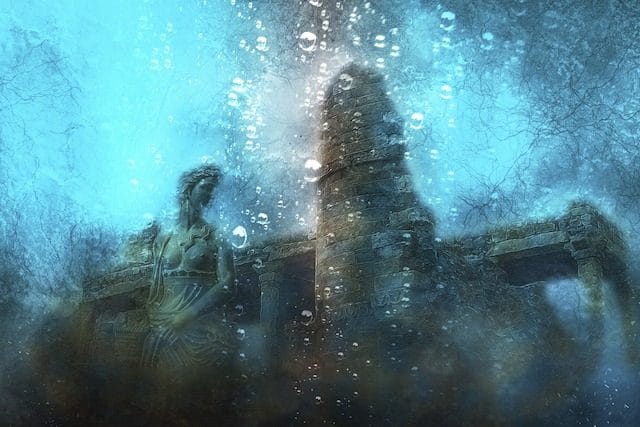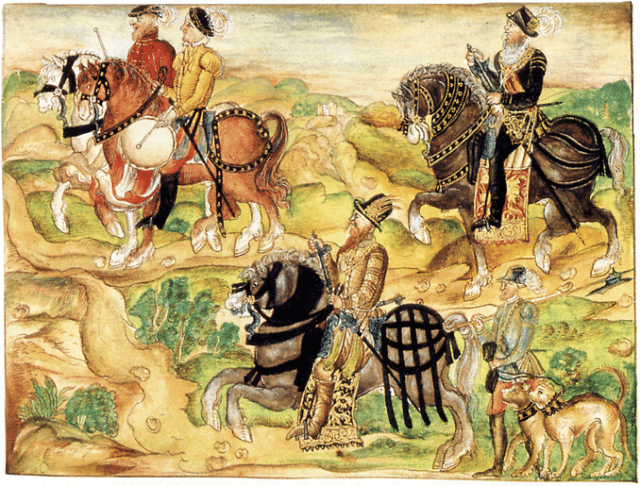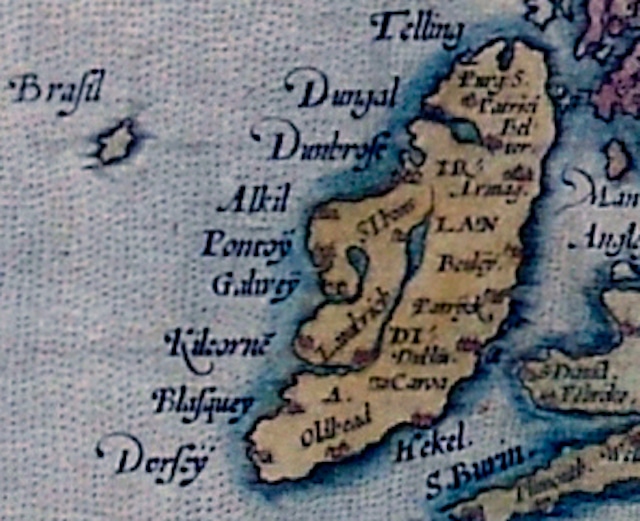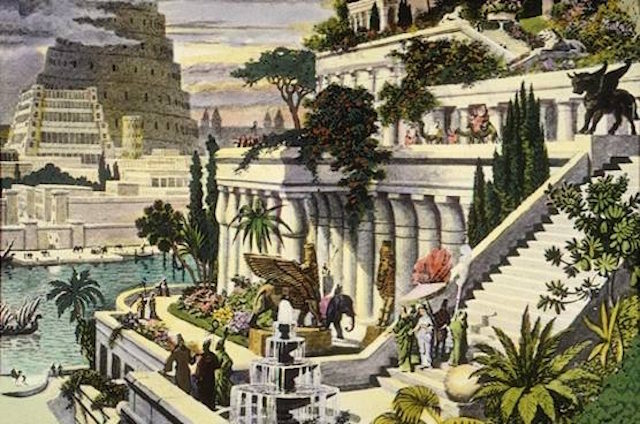Myth and legend are full of wondrous places that capture the imagination and have inspired generations of adventurers to explore the world in search of their treasures. Often they come up empty-handed, but every once in a while there seems to be a sliver of truth to the tales of these mythical places. Let’s take a look at 10 that may have been based in some degree of reality.
10. Atlantis

The story of Atlantis can be traced to the Greek philosopher Plato. He spoke of the fabled land back in 360 BC. In Plato’s telling, Atlantis was a land of rich and powerful people who were technologically advanced. It was not a complimentary tale though, and his stories about it were meant to illustrate that their knowledge and might had corrupted them as a people.
For most of history these tales were regarded as allegorical, used by Plato to illustrate a point. There are no other writings of the time that ever mention anything like Atlantis, so it was generally considered just to be something he made up to be illustrative. Not everyone believes that was the case though.
In more recent years, the belief that Atlantis may have been based on Minoan society has achieved some notoriety. The Minoan kingdom, ruled by King Minos, was said to be remarkably wealthy and advanced and had spread across much of Ancient Greece.
Minoans had paved roads and were believed to have been the first Greek society to use a written language. And then one day they vanished. It’s believed that sometime around 1600 BC a massive earthquake set off the volcanoes on the Minoan island known as Thera, burying it and destroying the culture forever.
9. Norumbega

Norumbega was said to be a legendary land of riches, named for an Algonquin word for the area, discovered by the Vikings well before North America was settled by Europeans. It showed up on maps in the 1500s and was situated around modern-day New England.
Archaeological evidence doesn’t support the idea that the Vikings ever settled anywhere that far south, and there’s only one confirmed Viking settlement in North America that exists in Newfoundland. That doesn’t mean there weren’t others though, and there is some evidence to suggest that perhaps Vikings did in fact settle farther north in places.
So what about Norumbega? The people of Boston commissioned a statue of Leif Erikson in the 1870s, in honor of his discovery of this legendary land.
In Viking tales, North America was called Vinland, or at least that’s what some people believe. Other historians who have analyzed the often contradictory data presented in Viking sagas have determined that Vinland couldn’t be where the Vikings landed in Newfoundland because of the lack of certain features like salmon and grapes. It’s believed that those things were found farther south around Martha’s Vineyard, perhaps as far down as Boston, which would have lent itself to the Norumbega myth.
8. Shangri-La
The legendary city of Shangri-La traces its origins to the works of British author James Hilton. He wrote of the city in his 1933 novel “Lost Horizon.” According to Hilton, Shangri-La was essentially an earthly paradise hidden within the Kunlun Mountains. While many have dismissed the story as pure fantasy created by Hilton, others believe that there’s some truth to them. Especially because Tibetan myths hold that there were several such cities hidden within the mountains.
In 1998, explorers trekking through the area discovered an area that they believe may have actually inspired the Shangri-La story. To the best of their knowledge, no Western humans had ever set foot in this place. Called “The Hidden Falls of the Tsangpo,” this valley of lush greenery was hidden even from satellite imagery in the mountains.
7. El Dorado

The legendary city/kingdom/empire of El Dorado is arguably one of the most interesting in all of mythology. Conquistadors searched throughout South America to find this place, which was apparently a vast city made of solid gold. While some legendary places were based entirely in fiction, and other places like Xanadu turned out to actually be real, the truth about El Dorado is a complete sidestep from either of these things.
Perhaps the results of the same phenomena that happens during the telephone game, when you tell a story to one person and they tell it to another, and they tell it to another, and the details get muddled, the truth of El Dorado also changed over time.
The idea that El Dorado was a golden kingdom came from something a little less vast, but still pretty impressive. El Dorado was no kingdom, but a king. Archaeological evidence shows that El Dorado was a person who was, for all intents and purposes, golden. This Chieftain would be covered from head to toe in gold and every day would bathe in a sacred lake to wash the gold off before applying it again the next day.
Unlike most other legends, this makes El Dorado curiously true and false at the same time, sort of like Schrodinger’s cat: neither outcome was expected, but not entirely false either.
6. Camelot

The story of King Arthur and the Knights of the Round Table is a pretty fantastic one, especially when you consider it involves pulling a magical sword from a stone, and a wizard. These things are generally not found in real life history. Despite that, there’s some evidence that Arthur’s stomping grounds, better known as Camelot, was an actual real place at some point in time even if Arthur was never a real man, or perhaps a gestalt of several kings.
Retired British Professor Peter Field believed he stumbled upon the actual location of Camelot while doing some research. Based on his findings, he came to the conclusion that Camelot was a Roman fort at Slack, to the west of Huddersfield in West Yorkshire.
The Roman fort, called Camulodunum, was strategically placed but currently exists underneath a golf course, so any excavation is probably going to have to wait a few years.
5. Hy-Brasil

Said to be located off the coast of Ireland, the island of Brasil, sometimes called Hy-Brasil so as to not confuse it with the South American country, is supposedly hidden except for one day every seven years. You don’t need to have a degree in geography to know that’s not a realistic feature of most islands, which is why it’s generally considered to be purely fictitious.
Despite the mysterious nature of the island, there have been accounts of people discovering similar places over the years. The island appeared on maps as early as the year 1325 and continued to appear on maps all the way up to the year 1800.
Several explorers and sailors claimed to have either seen, or even visited the island, though most who went in search of it came back empty-handed. It’s been theorized that the Porcupine Bank might be the actual source of the story — a raised shoal in the general vicinity where Hy-Brasil was said to exist.
4. Hanging Gardens of Babylon

Constructed in the 6th century BC by King Nebuchadnezzar II, the legendary Hanging Gardens of Babylon were supposed to be quite the sight to behold. Cascading gardens that reached 75 feet in height and featured flowers, herbs and all manner of exotic plant life to such an extravagant degree they became known as one of the Seven Wonders of the Ancient World. And as far as anyone knew in modern times, they had never existed at all.
In order for such a garden to have existed, an impressive irrigation system had to have been constructed to bring enough water into the desert for all the plants to thrive. No evidence in modern times has ever been found to indicate such a massive undertaking ever existed around Babylon. It doesn’t necessarily mean it didn’t exist though.
According to research by Dr. Stephanie Dalley, the reason we never found any evidence of the Hanging Gardens in Babylon was that they were never in Babylon in the first place. She believes she discovered evidence of their existence and the ancient city of Nineveh, part of the Assyrian Empire.
Dalley’s research shows Assyrian King Sennacherib was responsible for an extravagant garden about a century before the supposed Babylonian version. His writings describe such a thing, including irrigation technology thought to not exist until four centuries later.
3. Zerzura

West of the Nile, somewhere in the desert in Egypt or Libya, was said to be the legendary oasis of Zerzura. Written accounts of it can be traced back to the 13th century, mentioning a city that was as white as a dove. It was said that it is ruled by a sleeping king and queen; it was guarded by black giants, and it was full of treasures.
Numerous European explorers set out to discover the location of Zerzura in more modern times, some as late as the 1930s. It was in 1932 when Hungarian Explorer Laszlo Almasy led an expedition through the desert and discovered a series of wadis. Though there was no shining white city with a sleeping king, the truth was that they did discover some oases in the desert that had been clearly visited by the local Tebu nomads who had built huts around the area.
It’s worth noting that in the recounting of Almasy’s tale, he started his day of discovery by dusting the desert sand off of his plane. Had there been something in that area in the past it’s just as likely that the desert had swallowed it and only the vegetation remained. Regardless of whether there was a real city or not, the oasis does seem to exist and it’s possible something else may have once been there as well.
2. Thule

In ancient Greek and Roman writings, the farthest north you could get was a land called Thule. It was in the 4th century BC when Greek explorer Pytheas came to Athens with stories of this land where the sun never set and the land and ocean came together in a sort of jelly-like substance. So that was weird.
In later years some people came to believe that perhaps what Pytheas was describing was Iceland or even Greenland, but the details didn’t always line up. In time people came to believe that perhaps Pytheas had just made up the entire story. The only problem was he had been consistently reliable with what he had written about in the past. And the fact remains that his description of the Arctic summer was accurate. When you go far enough north, you will reach places where the sun stays up for days at a time. It would be a remarkable thing for him to have just guessed that.
Pytheas claims to have discovered the land six days across the sea from the Orkney islands. The people there were said to be fair skinned and with light hair, and barbarians by his description. In later years the Nazis would latch onto this story and mount their own expedition to find Thule, believing it to be the birthplace of the Aryan race.
Obviously the Nazis never found this mythical land of Aryan supremacy, but there were enough details of a land that clearly existed somewhere in the Arctic to confirm that wherever Pytheas had gone, it was likely a real place.
1. Sodom and Gomorrah

In the biblical story of Sodom and Gomorrah, God told Abraham that the two cities were going to be destroyed because of how wicked the inhabitants were. Abraham’s nephew Lot lived in one of those towns and Abraham didn’t really want to see him destroyed. Only Lot and his family were worthy enough to live, so they were told they could flee just as long as they didn’t look back. But as they left, Lot’s wife took a peek and was turned into a pillar of salt. As for everyone else in town? Nothing remained.
You’d think the historical evidence for two cities destroyed by God himself would be pretty thin. But there is a belief that the two cities did exist and the ruins are currently near a former peninsula of the Dead Sea in Israel. As for God’s wrath, it took the form of an earthquake that was believed to hit the region around 1900 BCE, and naturally occurring petroleum and other gases in the area may have actually exploded and rained fire at the time.